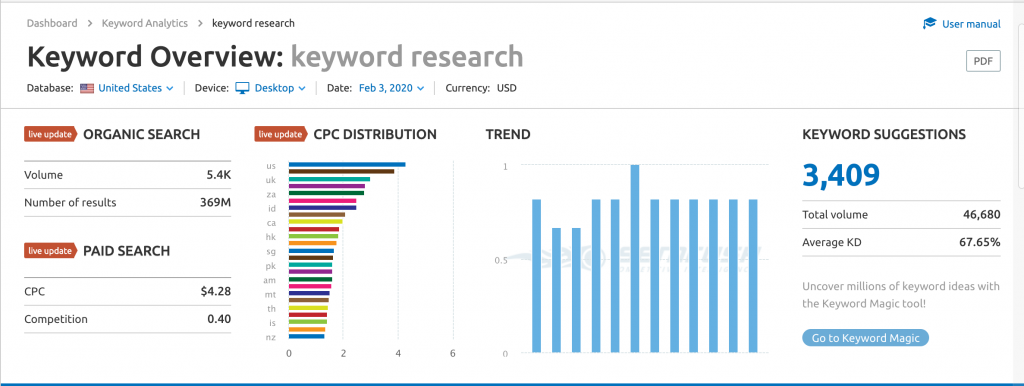SEO: Unlocking the Right Keyword

Think of your favorite food. Now Google it. What comes up? You’ll first be hit with highly rated restaurants near you that serve your cuisine of choice. Then Google will prompt you with its People Also Ask related queries. Then will come the top pages. And what do these top results consistently have in common? Each page’s synopsis will feature in some part, a keyword.
How did you phrase your query? Best Italian food? Top Korean BBQ recipes? Most popular ramen spots? The wording of your question will be returned to you in every page’s excerpt. Google is becoming less of a search engine and more of a glorified Q&A machine. And if you’re searching for the best SEO and the perfect keywords, start at the beginning: what questions from your audiences need answering?
SEO Tools
To have something approaching a keyword/phrase strategy, baseline analytics have to be established. You’ll need a proper SEO tool for this research and the following three all provide comprehensive keyword research capabilities.

Once in these platforms, plug in a series of keywords that address the following:
- Which terms are your users searching for?
- Which terms do you want to be searched for?
- Which terms make relevant sense for your existing content?
SEO Terminology
You’re going to be bombarded with a lot of metrics and terminology at this point. Here’s a breakdown:
- SERP: Search Engine Result Pages’, i.e., what’s returned after a Google query
- Domain/Page Authority (DA/PA): a metric determining a site and/or page’s capacity to rank on Google
- Metadata: self-descriptions of your content plugged into your CMS
- Meta Description: when a page is returned on Google, its excerpt is that page’s meta description; try not to repeat any words in these; 135 – 160 characters with keywords is ideal
- Page Title: 50-60 characters with keywords
- Alt-Text: describing all visual assets for ADA compliance/screen readers
- Interlinking: linking from one page on your site to another; include at least two of these per page within hyperlinks or CTA buttons (take the user to a place with a strong PA)
- Backlinking: links to other sites; ideally ones with a healthy DA
- Headers: keywords in H2s and H3s will be given more weight than ones in body content
- URL: these should not be randomized; they can be the title of the page (or something similar), feature keywords, and every-word-should-be-separated-by-a-hyphen
Keyword Difficulty made Easy
When deciding upon whether it’s worth or possible to rank for a particular keyword, you’re going to brush up against Keyword Difficulty (KD). This metric is derived from the authority of the domains on the results page and the challenge for a new website to outrank its current competitors on the SERP.
KD Score Range:
- High: 80-100
In order to rank here, you would need to invest in SEO and link-building practices; if you’re working with a brand new site, these keyword targets may be out of reach. - Medium: 60-79
Landing on the first page of keywords in this range isn’t easy but it’s plausible, especially if your website has some cachet in your industry.
- Low: 59-20
These keywords are the easiest to rank for but the hardest to find. Keywords in this range that also have a steady search volume represent your best opportunities here.
Remember though, this is on a sliding scale. If you’re an established monolith of content like Hubspot, a KD of 80 might not be difficult at all. If your site is small/nascent, a KD of 60 might seem insurmountable. When you’re after the rarefied air of top keywords, it’s more about backlinks and DA. You should not strategize around keywords, but they should instead be surfaced from the content you already have.
If you’re questioning what makes for good SEO, it’s ensuring that your site answers your audience’s questions.
Context is King
- Branded vs. Non-Branded Keywords
Branded keywords include an organization’s name, e.g. Amazon Careers or Apple Stores. Again, if you’re a universally recognizable brand, this makes sense to leverage. But if you’re lesser-known, users aren’t searching for your brand yet — so reaching a new audience is possible by tapping into high-volume, non-branded keywords with a reasonable KD. These are terms users are already searching for and would be most effective at maximizing your search engine visibility.
- Local SEO
This is the strategy of choosing keywords that highlight your physical location — are you a nonprofit in DC or Toronto? How integral is your location to your brand identity? How well-known are you in your area? Are users already searching for spots in your neighborhood? Leverage your location.
- Long-Tail Keywords
These are lengthier and more specific than a general search query, e.g., best SEO advice for startups in 2020. Their strength is in their specificity, for as fewer sites are competing for these long-tail keywords, you can corner the SEO market on a niche term and be found by new, motivated audiences.
Keyword Takeaways
- Compete for keywords with a KD under 80
- Apply high-volume non-branded keywords
- Also include lower-volume specific terms
- Combine these into long-tail keyphrases
- Use your keywords in your body copy, headers, meta descriptions, and URL
Waiting to be Found
Even if all these SEO keyword tactics are implemented, it’s never going to be an instant fix that suddenly has your site appearing as the first result on Google. But with enough strategically chosen keywords, implemented consistently enough, over a long enough time, you will show incremental gains for your site’s visibility. Think of keywords as a tedious prerequisite, not a bit of digital magic. Was that the answer you wanted?
